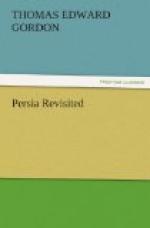‘A horse! a horse! my kingdom for a horse!’
After the racing stud came the riding-horses, sixty-two in all: deer-like Arabs of the best desert blood of Nejd and Anizah, and others of a stouter build from the country of the Jaf Kurds; selected cross-breeds from Persian and Turkish Kurdistan, and bigger-boned animals from the Karadagh, the result of a strong strain of good Northern blood. There were some long, low, powerful Yamut and other breeds from the Turkoman country, and some good-looking active small horses from Khorasan. From the Kashkai breeding-grounds near Shiraz were shown some fine big horses of high quality, also neat, stout mixed breeds from the hills and plains of Luristan and Persian Arabistan; and Arabs of the best type, bred from ‘blood stock’ by the Shah’s sons, also choice specimens from the royal home farms.
Three gray Arabs, favourites of the late Shah, were brought out, set off with gold collars, and their points were gone over to show how powerfully safe they were as riding-horses on the hillside and the plain. One of them was said to be getting too old for good work, but he was bursting so with flesh and spirits that he threw out before and let out behind in such vigorous wide-circling style as to scatter the crowd of spectators, gholams, guards, and grooms. The most powerful and best-shaped among the riding-horses, in my opinion, were a Jaf (Kurd) dappled gray, and two big gray Turkomans, the latter very deep in the girth, and distinguished by the long, fine neck so common to their class, and rather large but lean heads, showing blood and breeding. The Turkomans say that the superior size and strength of their horses over others are due to the rich grass of their pasturelands, I may conclude this short account of the royal stud by mentioning that, as Persia is essentially a country of horses and horsemen, every foreign Minister on first arrival and presentation to the Shah receives the gift of a horse from his Majesty’s stables. All these horses had their tails plaited or tied up. The Persians never cut a horse’s tail, but tie it up, which not only improves the animal’s appearance, but prevents the tail trailing on the ground, or being whisked about when wet or dirty, to the annoyance of the rider. The tail is only knotted up when the horse is made ready for riding, otherwise it remains loose, to be used for flipping off flies.




